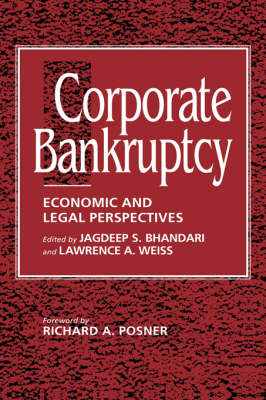
Corporate Bankruptcy
Cambridge University Press (Verlag)
978-0-521-45717-0 (ISBN)
This collection is the first comprehensive selection of readings focusing on corporate bankruptcy. Its main purpose is to explore the nature and efficiency of corporate reorganisation using interdisciplinary approaches drawn from law, economics, business, and finance. Substantive areas covered include the role of credit, creditors' implicit bargains, non-bargaining features of bankruptcy, workouts of agreements, alternatives to bankruptcy, and proceedings in countries other than the United States, including the United Kingdom, Europe, and Japan.
Foreword the Honorable Richard A. Posner; Part I. The Role of Credit: Editor's introduction; 1.1 Leverage, Nobel prize lecture (1990) Merton H. Miller; 1.2 Agency costs of free cash flow, corporate finance and takeovers Michael C. Jensen; 1.3 A theory of loan priorities Alan Schwartz; Part II. Bankruptcy as a Reflection of the Creditors' Implicit Bargain: Editors' introduction; 2.1 A world without bankruptcy Douglas G. Baird; 2.2 Bankruptcy, non-bankruptcy entitlements, and the creditors' bargain Thomas H. Jackson; 2.3 Translating assets and liabilities to the bankruptcy forum Thomas H. Jackson; 2.4 Bankruptcy policy Elizabeth Warren; 2.5 Loss distribution, forum shopping, and bankruptcy Douglas G. Baird; Part III. Beyond the Basic Creditors' Bargain: Editors' introduction; 3.1 Bargaining after the fall and the contours of the absolute priority rule Douglas G. Baird and Thomas H. Jackson; 3.2 On the nature of bankruptcy Thomas Jackson and Robert E. Scott; 3.3 A simple noncooperative bargaining model of corporate reorganizations Douglas Baird and Randal C. Picker; 3.4 On the nature of bankruptcy Mark J. Roe; 3.5 Bankruptcy and risk allocation Barry E. Adler; 3.6 The corporate bankruptcy decision Michelle J. White; 3.7 Bargaining over equity's share in the bankruptcy reorganization of large, publicly held companies Lynn M. LoPucki and William C. Whitford; 3.8 Bankruptcy resolution Lawrence A. Weiss; 3.9 The costs of conflict resolution and financial distress David Cutler and Lawrence Summers; 3.10 Survey of evidence on business bankruptcy Michelle J. White; Part IV. Workouts or Bargaining in the Shadow of Bankruptcy: Editors' introduction; 4.1 Managing default Stuart C. Gibson; 4.2 The economics of pre-packaged bankruptcy John McConnell and Henri Servaes; Part V. Alternatives to Bankruptcy and the Creditors' Bargain: Editors' introduction; 5.1 Corporate control and the politics of finance Michael C. Jensen; 5.2 The uneasy case for corporate reorganizations Douglas G. Baird; 5.3 Bankruptcy and debt Mark J. Roe; 5.4 A new approach to corporate reorganizations Lucian A. Bebchuk; 5.5 Debtor's choice Robert K. Rasmussen; 5.6 Is corporate bankruptcy efficient? Frank H. Easterbrook; 5.7 The voting prohibition in bond workouts Mark J. Roe; 5.8 Financial and political theories of American corporate bankruptcy Barry E. Adler; Part VI. Experience of Other Countries: Editors' introduction; 6.1 Lessons from comparison of US and UK insolvency codes Julian R. Franks and Walter N. Torous; 6.2 The costs of corporate bankruptcy Michelle J. White; 6.3 Should we abolish Chapter 11? Theodore Eisenberg and Shoichi Tagashira; 6.4 The role of banks in reducing the costs of financial distress in Japan Takeo Hoshi, Anil Kashyap, and David Sharfstein.
| Erscheint lt. Verlag | 29.3.1996 |
|---|---|
| Vorwort | Richard A. Posner |
| Zusatzinfo | 8 Line drawings, unspecified |
| Verlagsort | Cambridge |
| Sprache | englisch |
| Maße | 152 x 228 mm |
| Gewicht | 857 g |
| Themenwelt | Wirtschaft ► Betriebswirtschaft / Management ► Finanzierung |
| Betriebswirtschaft / Management ► Spezielle Betriebswirtschaftslehre ► Bankbetriebslehre | |
| ISBN-10 | 0-521-45717-3 / 0521457173 |
| ISBN-13 | 978-0-521-45717-0 / 9780521457170 |
| Zustand | Neuware |
| Haben Sie eine Frage zum Produkt? |
aus dem Bereich


